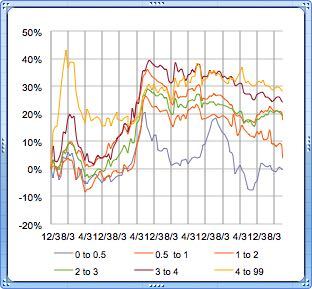How Are Diamonds Made? Natural vs Lab-Created Explained
Two Paths, One Diamond Not all diamonds come from the same place — but they all start the same way. Pure carbon, crystalized under immense pressure and heat. Whether it…
Loose diamond grading may be performed by any credentialed professional. The most strict and secure diamond grading is performed by top-tier laboratories issuing diamond certification (or grading reports) for loose diamonds, following a detailed process of intake and analysis.
PriceScope Pointer: Did you know a laboratory’s preliminary color and clarity grades can be challenged if the diamond’s owner doesn’t agree? This diamond grading recheck process is frequently successful.
Before going on: Check out the PriceScope Diamond Buying Guide
These pages may reference products from companies that help to support PriceScope.
Wondering which of the many diamond colors is best for you? Our elite list of vetted vendors like Whiteflash and James Allen are experts at listening and helping you determine which combo of the 4Cs is perfect for you - and nicely in budget. Contact Us and get help today.
A diamond’s grades, printed on a diamond certificate (or grading report) are used to establish its value. The diamond grading system developed by GIA in the 1950s is traditionally used describe and classify diamonds in four key areas: Carat, Cut, Color and Clarity. That diamond 4Cs assessment will be used to establish the diamond’s value.
Diamond grading is subjective, especially in the areas of color, clarity and cut. To keep diamond grading consistent, top-tier laboratories and appraisers use calibrated master color stone-sets and uniform clarity standards to ensure a baseline of uniformity. Nevertheless, a diamond that falls directly on the border of two grades may come out on one side of the other, depending on the subjective opinion of the gemologist making the judgment. Diamond grading also becomes very granular at the high end of the color and clarity scales.
Due to the subjective nature of color and clarity judgments a standard deviation of +/- one grade is deemed acceptable among professionals in the diamond grading industry.
This is perfectly logical from an analytic standpoint. At point of sale, however, a difference of +/- one grade may have significant influence on value. For this reason, it’s important for a buyer and a seller to agree on the diamond certificate (or grading report) which will serve as the document of authority prior to sale.
The influence of standard deviation on diamond grading and value is mitigated when you buy from a seller who offers a full credit upgrade policy. Under such a policy the full amount you pay remains available for you to apply again to a different diamond, apples to apples, for the duration of that policy.
Long term benefits: For their in-house categories, Whiteflash offers a 100% trade up credit toward a new diamond of equal or greater value than your original purchase. Blue Nile and James Allen offer a 100% upgrade credit toward any new diamond costing 2X or more than your original spend. That means the money you invest with these PriceScope vendors can ultimately be used again, toward your next significant purchase.

PriceScope’s 1-5 star ratings are categorical comparisons with the most thorough, consumer-focused online diamond and jewelry vendors, in categories, we believe reflect our experienced consumer community’s values. Check out PriceScope Jeweler Reviews.
Consumers should be aware that diamond grading happens on several different levels of quality attention by those performing the analysis.
Diamonds costing hundreds or thousands of dollars should be graded by a top-tier laboratory, capable of detecting the most modern treatments, enhancements and lab grown origin.
Diamond and gemstone jewelry costing hundreds or thousands of dollars should also be certified by a top-tier laboratory, capable of detecting the most modern treatments, enhancements and lab grown origin. The report should be item-specific, providing specific 4Cs assessment of the center stone (not split color or clarity grades), weight and precious metal alloy used for the setting and general details of all side stones, if present.
Generic reports accompanying economical pieces like those seen in department store jewelry counters should not be confused with loose diamond certification (or grading reports). These documents are not item-specific, they are mass-produced to describe a production run of numerous similar pieces. They are not nearly as strict, accurate or expensive as stand-alone diamond grading reports or jewelry identification reports, prepared for a specific piece.
Discount sellers in commercial markets may diamond grading reports issued by organizations willing to intentionally over grade diamonds. This occurs when an appraiser, laboratory or seller continually promotes diamonds as having better color or clarity grades than they would normally receive according to strict, industry-accepted international standards, misrepresenting those diamonds to buyers.
Various EGL International overseas locations were exposed for over grading diamonds, prior to the organization being delisted by trading platforms, including PriceScope.
Diamond grading at top-tier laboratories follows a strict sequence of intake, analysis and reporting.
Upon receipt, a diamond’s manufacturer’s part number (MPN) is recorded, and a unique tracking number is assigned by the laboratory. This tracking number frequently becomes the diamond grading report number.
Diamond grading is anonymous. No company or submitter names are included which may identify the owner. Even the MPN may be redacted, to ensure no favoritism or bias. The most sophisticated laboratories include a chip in the diamond’s parcel by which it can be electronically tracked, to determine its location at any given moment. Analysis is conducted randomly and separately: the diamond returns to central control following each stage of grading, so the gemologists it becomes exposed to are random.
The first stage in diamond grading is weighing the diamond. Diamond grading scales are calibrated to three decimal places. Most laboratories establish carat weight to two decimal places, with the exception of the AGS, which reports to three.
Measurements
A diamond’s measurements are established using a 3D scan created in a diamond scanning device. In this process the diamond is placed upside-down on a rotary platform, surrounded by lights. The lights turn on and the silhouette of the diamond is captured eight times as it rotates. An integrated camera measures the angles of that silhouette.
The second stage of diamond grading is the analysis of clarity and polish & symmetry, known collectively as finish.
First Impression
The reason clarity analysis is traditionally performed before color analysis is so the ‘first impression’ for a solo grader is clarity. That first impression, at 10X magnification, will determine the broad range of clarity into which that diamond should fall. Diamonds with characteristics which are immediately obvious or noticeable at 10X will fall into the lower five grades, whereas diamonds with characteristics which are minor, minute or extremely difficult to find at 10X will land in the higher grades.
The gemologist next examines polish and symmetry quality and inspects the diamond for any treatments or enhancements such as laser drilling and resin filling. The polish and symmetry grades, and existence of any treatments are recorded.
The gemologist uses a process known as the wedge technique, examining the diamond in segments, noting the location and nature of all relevant clarity characteristics on a clarity plot, creating a map of its characteristics.
The third stage of diamond grading is an analysis of color and fluorescence, if present.
Gemological laboratories perform diamond grading of D to Z color with the diamond upside down and viewed through the side. This is done to permit a neutral view. Viewing a diamond from the top is not neutral because of three factors which may influence diamond color appearance in the “face-up” position:
The gemologist places the diamond face down, against a neutrally colored background, under diffused lighting. The subject diamond is compared to a set of calibrated master color stones, D-Z. Each master stone has the least amount of color in its range. This permits the gemologist to compare the diamond until it precisely matches a master stone, or lands below that master and above the next – in which case it’s the color of the higher master.
The gemologist inspects the diamond for fluorescence under special UV lighting. If fluorescence is present, the strength and color of the fluorescence is recorded.
With both clarity and color analysis, a second gemologist will take the diamond through the grading steps and provide a second opinion, completely independent from that of the first gemologist. When necessary, a senior gemologist reviewing the grades of the first two gemologists may record a third opinion. The color and clarity grades are only finalized when a consensus is reached. This helps minimize the subjective deviation present in diamond grading.
Most of the world’s diamond grading laboratories, including the GIA and the IGI, take a round brilliant diamond’s average proportions, according to its 3D scan, and apply them to diamond grading charts to establish the cut grade. Since the proportions are based on two-dimensional averages the cut grade is not diamond-specific. Most laboratories using proportions grading do not grade the cut of fancy shapes.
The AGS laboratories and GCAL import the diamond’s 3D model into software designed to follow the light as it travels through the diamond, taking its total sculpture into account. This computer modeling approach is called ray tracing and is diamond-specific. It can also be used to grade the cut of fancy shapes.
Grades for polish and symmetry are applied to the diamond grading process for cut. These finish grades, if lower than the proportions or performance grade, can cause the overall cut grade to be lowered.
After diamond grading stages 1-4 are complete a preliminary report is prepared and sent for the submitter/owner of the diamond to review. If the owner disagrees, they may ask the diamond grading laboratory to recheck certain grades (described below). Once preliminary reporting and recheck are complete the owner will send instructions to the diamond grading laboratory.
If the owner requests it, the diamond grading laboratory will laser-inscribe each diamond, typically with their internal tracking number, which now becomes that diamond’s grading report number. If the diamond belongs to a brand or specific store, the owner may also have a logo inscribed. These inscriptions will be noted on the diamond grading report.
If the owner requests it, the official grading report will be printed (except digital-only report formats). Diamond grading reports are printed with holograms and other security features, then laminated to prevent alteration. The diamond is weighed, verified as matching the report by central control, steam-cleaned and prepared for return to the owner along with the new diamond grading report, which is placed in a protective sleeve or binder.
Once the diamond and report have left the diamond grading laboratory premises a digital copy of the report will be posted online.
If you’re looking to buy loose diamonds online, use our special tools to reveal the best cut quality diamonds! Start your diamond search and choose from over a million loose diamonds for sale. Use our filters to find either natural or lab diamonds, as well as fancy color diamonds.
Although top-tier laboratories apply similar standards, the subjective nature of diamond grading, particularly with color and clarity, creates a situation where a diamond’s owner may disagree with a laboratory’s assessment. Top-tier laboratories acknowledge the existence of standard deviation and account for that possibility by offering submitters the opportunity to have grades “rechecked.”
This is facilitated by sending an email with preliminary results to the person or company who submitted the diamond. Upon request, the laboratory will honor ‘rechecks’ of any grades in question.
The lab’s central control performs rechecks in the same anonymous manner as preliminary grading. For example, if a color grade is challenged, the diamond goes through the color grading process again. If the fresh result comes back in agreement with the owner’s challenge the grade will be changed. If the result comes back as it was before the grade will not be changed.
The owner is charged a fee for each grade rechecked, regardless of outcome. This is to prevent producers from compulsorily rechecking all grades, hoping some will be improved in the process. It also compensates the laboratory for the extra time on task.
Example A
Example B
In example C the preliminary color grade was better than the owner expected. Whether this is due to the owner being conservative, the laboratory gemologists being liberal, or a legitimate on-border grade, such preliminary results are not usually challenged down by owners. Instead, the printed reports are considered lucky certs, since the diamond will command a higher amount than anticipated by the owner.
While some top-tier laboratories will accept downward challenges, in the interest of the owner maintaining brand integrity, it’s worth noting the GIA has no mechanism whereby a preliminary grade can be lowered. They will only consider challenges that will raise a preliminary grade.
Get fast answers to any question: Ask our community of unbiased independent helpers.
Ready to find your diamond?
People also ask
Some people believe the higher the grades the better the diamond. Others believe the combination of grades should be chosen based on personal desires and budget. Read more on our page about Diamond Quality.
Diamonds in the top five categories all have identical clarity to the naked eye, so this C presents an opportunity to stretch your budget. Read more on our page on Diamond Clarity.
A G color diamond does not command the premium of colorless diamonds, yet remains extremely white. Read more about G color diamonds.
Get More Knowledge

Retail Diamond Prices Chart Updated Monthly.

Two Paths, One Diamond Not all diamonds come from the same place — but they all start the same way. Pure carbon, crystalized under immense pressure and heat. Whether it…
A Wedding Ring as Unique as Your Love Finding the right wedding ring isn’t just about diamonds or gold – it’s about finding the one that feels right. With hundreds…
So, you’re thinking about lab-grown diamonds? Smart move. They’re just as sparkly as the natural kind but usually cost less. But where do you actually go to buy them? It…

Want to stay updated on the most recent blogs, forum posts, and educational articles? Sign up for Bling News, PriceScope’s weekly newsletter.